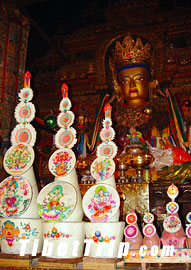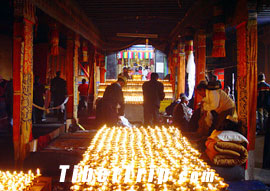 Butter Sculpture represents an unusual form of sacred art that reflects Tibetan Buddhism. These artistic forms are often given as offerings to please deities that are said to reside in the shrines, as well as decorating the auspicious box cherma appearing in the celebration of the Tibetan New Year and other grand ceremonies. A larger Butter Sculpture can be over ten meters (33 feet) long and four meters (13 feet) tall, but it can also be of the size of mere inches. The materials are mainly yak butter that is mixed with various mineral dyestuffs, which can be pinched into various lifelike and prolific patterns in coldness. These range from the images of deities, animals, plants, bonsais of fruits to pavilions, which can comprise scenes of legendary and historical stories or other Buddhist themes.
Butter Sculpture represents an unusual form of sacred art that reflects Tibetan Buddhism. These artistic forms are often given as offerings to please deities that are said to reside in the shrines, as well as decorating the auspicious box cherma appearing in the celebration of the Tibetan New Year and other grand ceremonies. A larger Butter Sculpture can be over ten meters (33 feet) long and four meters (13 feet) tall, but it can also be of the size of mere inches. The materials are mainly yak butter that is mixed with various mineral dyestuffs, which can be pinched into various lifelike and prolific patterns in coldness. These range from the images of deities, animals, plants, bonsais of fruits to pavilions, which can comprise scenes of legendary and historical stories or other Buddhist themes.
However, this wondrous art craft is not easily created. Butter sculpture involves an enormous amount of manual work and can only be fashioned during the extremely cold days of winter. A basin of water cools the hands of the artisans, since the warmth of their palms is enough to dissolve the butter. Despite the unendurable condition, the religious artisans consider it a meritorious and pleasant work to do.

 Butter Lamp Festival
Butter Lamp Festival
Every Jan. 15th of the Tibetan Calendar, the brilliant Butter Lamp Festival is held in Lhasa . With the arrival of nightfall, the butter lamps are lit in every house and temple. Additionally, all kinds of lovely Butter Sculptures will also be displayed in the shelves above the lamps, the sight of which often attracts numerous people to the spot. Barkhor Street around Jokhang Temple is always the noisiest. Ganden Monastery, where Tsong Khapa, the founder of Gelugpa or Yellow Hat Sect of Tibetan Buddhism is said to harvest his nirvana, also draws many pilgrims to worship at this time.
 Ta'er Monastery
Ta'er Monastery
Ta'er Monastery, which is located in Qinghai Province, is the most famous spot for Butter Sculptures. An exhibition hall in the temple was built especially for the display of the sculptures. Past exhibits are replaced each year by the best ones newly judged before every Jan. 15th of Tibetan Calendar for visitors to appreciate. It is no exaggeration to say that these Butter Sculptures are no less scintillating than the well-known waxworks of England.








